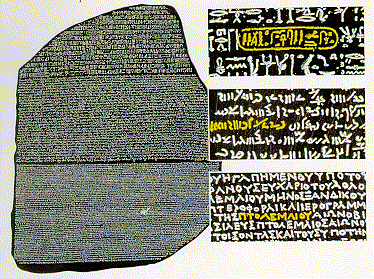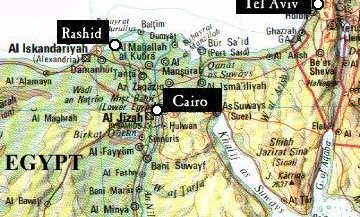
The Rosetta Stone led to the modern understanding of hieroglyphs. Made in Egypt around 200BC, it is a stone tablet engraved with writing which celebrates the crowning of King Ptolemy V. It is a solid piece of black Basalt and is 1m high by 70cm wide by 30cm deep. Quite heavy.
The interesting thing about the Rosetta Stone is that the writing is repeated three times in different alphabets:

Hieroglyphic (top of stone)- used by ancient Egyptians
Demotic (centre of stone)- used by Arabs including modern Egyptians
Greek (base of stone)- used by, Greeks, and other eastern Europeans

The stone was re-discovered in 1799AD at Rosetta near Rashid, about 200km north of Cairo on the Mediterranean coast. At that time, the meaning of hieroglyphs had been forgotten. Nobody could translate any of the hieroglyphs found whilst raiding/exploring ancient Egyptian archeology.
However, the Rosetta Stone changed all that. Because people of the 19th century could understand the Demotic and Greek parts of the engraving, a chap called Jean-Francois Champollion worked out which words were represented by which hieroglyphs in 1821AD.
The Rosetta Stone now rests in the British Museum in London.
Here is an extract from the writing on the Rosetta Stone:
Photo of the Place des Ecritures, Figeac, France An Egyptian tablet in the Louvre Museum, Paris
 Champollion was born in December 1790 and could speak Greek, Latin, Hebrew, Arabic, Chaldean and Syrian by the age of 14. By 19, Champollion was a History lecturer at Grenoble University. He had to make his translations from a copy of the Rosetta Stone, since the stone itself had been stolen/seized by the English during the Napoleonic war.Champollion visited Egypt only once- to put his new understanding of hieroglyphs to the test. He returned to France to found the Egyptology Museum at the Louvre in Paris (where you can still see many tablets and statues today). Champollion died in 1832 aged only 42.
Champollion was born in December 1790 and could speak Greek, Latin, Hebrew, Arabic, Chaldean and Syrian by the age of 14. By 19, Champollion was a History lecturer at Grenoble University. He had to make his translations from a copy of the Rosetta Stone, since the stone itself had been stolen/seized by the English during the Napoleonic war.Champollion visited Egypt only once- to put his new understanding of hieroglyphs to the test. He returned to France to found the Egyptology Museum at the Louvre in Paris (where you can still see many tablets and statues today). Champollion died in 1832 aged only 42.
Much of Champollion's work was based on that of Englishman Thomas Young who had already deciphered names of people and places. Words like these, called Proper Nouns, are bordered by hieroglyphic name rings, similar in shape to modern army name tags.
Hieroglyphic namering for King Ptolemy V
![]()
This page was made by Andrew Oakley.